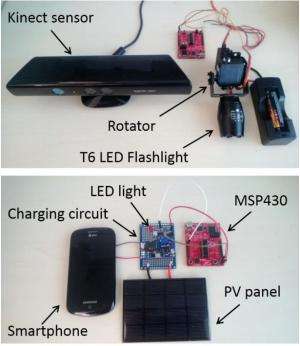January 20, 2015 weblog
Beijing team proposes effortless phone charging with light beams

"Hurry up, my phone's dying." A familiar wail heard on the move. Cutting-edge smartphones pose charging headaches faster than the smartphone owner likes, with their powerful multicore CPU and GPU cores, screens, high-speed wireless network interfaces, energy-expensive apps and continuous sensing tasks. Can a light beam ease the charging exercises to effortlessly charge a smartphone? Three researchers think so.
Yunxin Liu, Zhen Qin and Chunshui Zhao of Microsoft Research, Beijing, have written a paper on their work, "AutoCharge: Automatically Charge Smartphones Using a Light Beam." They have named their approach AutoCharge and, like its title suggests, is designed to relieve the smartphone owner of the burden of any explicit effort to juice up the phone. Two steps are involved, detection and charging. Think of their approach as a "solar charging" technique but applied indoors with a wireless lightbeam. Think of it also as an image-processing technique designed to detect and track smartphones on a desk for automatic charging. Their paper reports the prototype that they designed and implemented, discussing the light charger and the smartphone detection and tracking system. The AutoCharge results: the prototype was able to detect the presence of a smartphone in seconds. Charging time was as fast as existing wired chargers.
The AutoCharge device can be mounted into the ceiling and has a camera that can spot and identify phones. The authors said, "To be charged by the light charger, the smartphone must integrate a solar panel to harvest energy from the light beam of the light charger." They said that the light charger has four components: a light which generates a straight light beam (they designed the charger to generate a straight light beam with little scattering to improve efficiency and speed); a camera which monitors a surface like a table; a programmable rotator which moves the light and the camera to adjust their direction; and a controller that controls the movement of the rotator and turns the light on and off.
How it works: the charger identifies the opportunities of charging a smartphone when a user puts the phone on a desk. (If there are multiple smartphones on the same desk, the charger can charge them one by one.) The charger uses a camera to keep monitoring the surface. When a smartphone is put on the desk, the charger can quickly detect its presence. Once the charger has automatically located the smartphone, it starts to charge it if the battery is low. The charger uses a rotating motor to adjust the direction of its light beam so that it is able to accurately project the light beam on the smartphone. After the battery is full, the charging stops. (For safety, If the camera detects there is any object blocking the light beam, the controller of the light charger will immediately turn off the light. The authors said, "we must prevent the light beam from hurting people, particularly eyes as a kid may be curious and try to watch the light beam directly.") They said they made solar charging work for 24 hours per day, no matter the weather condition.
While results were encouraging, the AutoCharge faces one key issue: the AutoCharge approach does not work for existing smartphones. That is because the approach requires that the smartphone integrate a PV panel to work with a light charger.
"However, smartphones are consumer electronics and we see that smartphone makers like Apple and Samsung typically release a new generation of smartphones every year or even less than one year." Users also upgrade phones quickly and they are optimistic about opportunities to add new hardware and functions into next-generation smartphones. "Despite that our prototype implementation is still far away from a real product and may be further improved in many aspects, we have demonstrated the feasibility and made a significant step towards automatic smartphone (and other mobile devices) charging."
More information: AutoCharge: Automatically Charge Smartphones Using a Light Beam, Yunxin Liu, Zhen Qin, Chunshui Zhao - (PDF) research.microsoft.com/pubs/23 … 37/AutoCharge-TR.pdf
© 2015 Tech Xplore




















